Abstract
1. In seven normal subjects, subthreshold transcranial magnetic conditioning stimuli (using a figure-of-eight coil) were applied over the motor cortex in order to evoke activity in intracortical neuronal circuits. The net effect on cortical excitability was evaluated by measuring the effect on the size of EMG responses elicited in the abductor digiti minimi (ADM) muscle by a subsequent suprathreshold test stimulus. 2. A single conditioning stimulus suppressed the size of the test response at interstimulus intervals (ISIs) of 1-4 ms whereas the response was facilitated at ISIs of 6-20 ms. The facilitation could be augmented if pairs of conditioning stimuli were given. 3. Inhibition and facilitation appeared to have separate mechanisms. The threshold for inhibition (0.7 active motor threshold) was slightly lower than that for facilitation (0.8 active threshold). Similarly, the inhibitory effect was independent of the direction of current flow induced in the cortex by the conditioning shock, whereas facilitation was maximal with posterior-anterior currents and minimal with lateromedial current. 4. Direct corticospinal effects were probably not responsible for the results since facilitation of cortical test responses could be produced by conditioning stimuli which had no effect on the amplitude of H reflexes elicited in active ADM muscle. 5. Inhibition and facilitation appeared to interact in a roughly linear manner, consistent with separate inputs to a common neurone. 6. We suggest that subthreshold transcranial magnetic stimulation is capable of activating separate populations of excitatory and inhibitory interneurones in the motor cortex.
Full text
PDF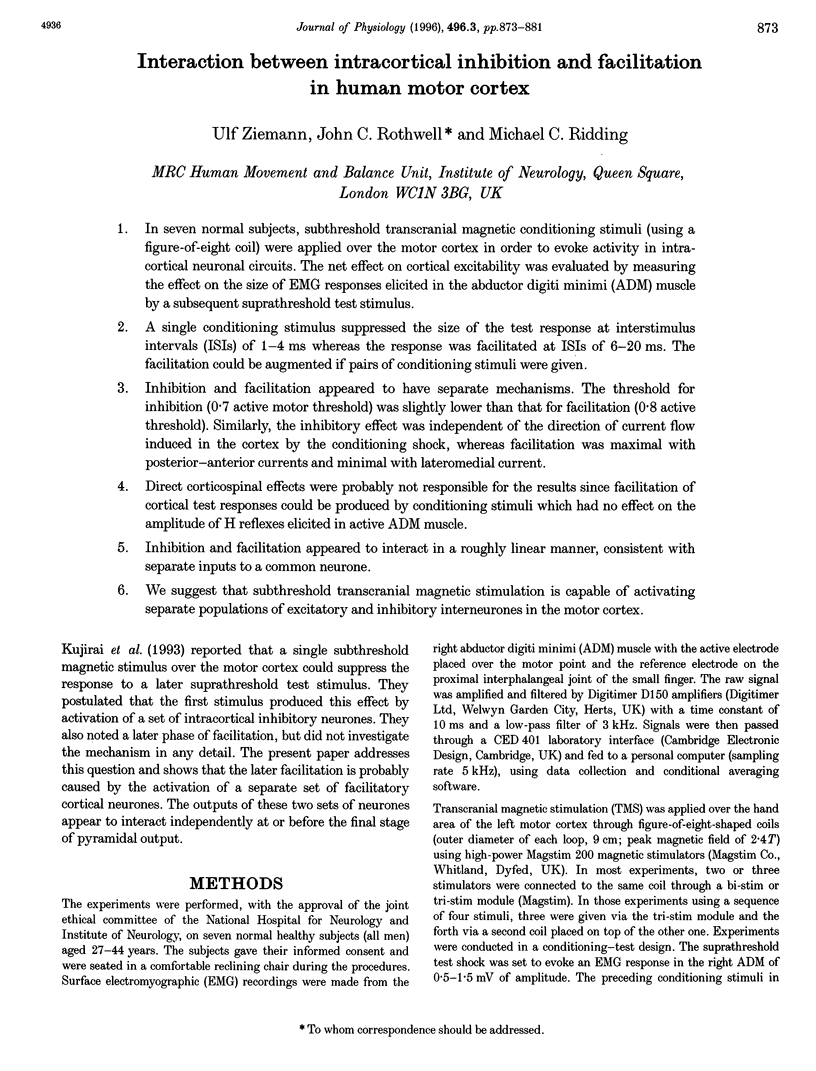
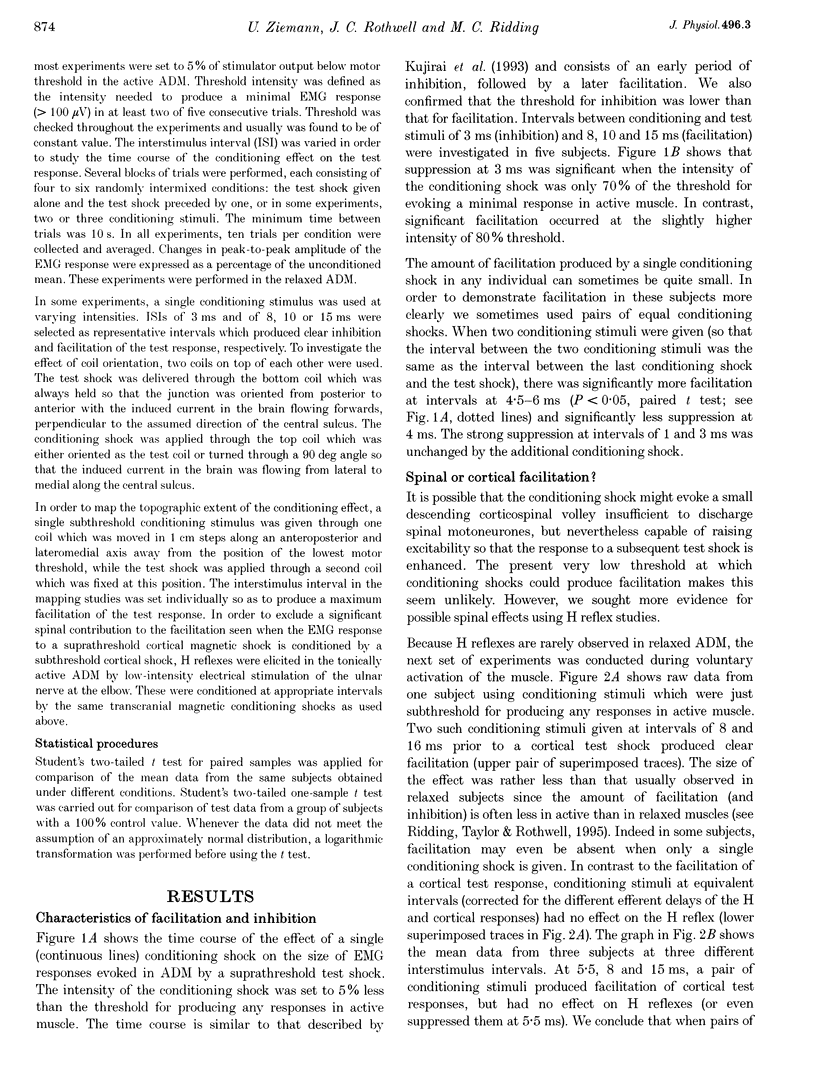
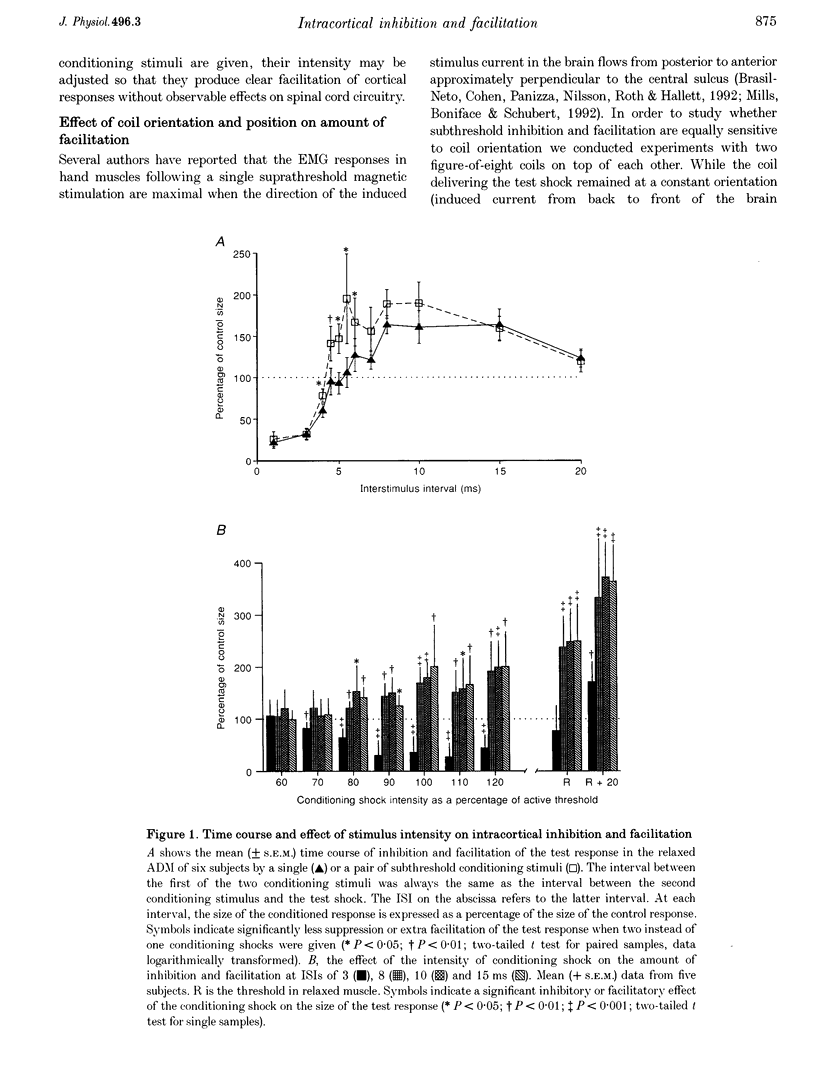
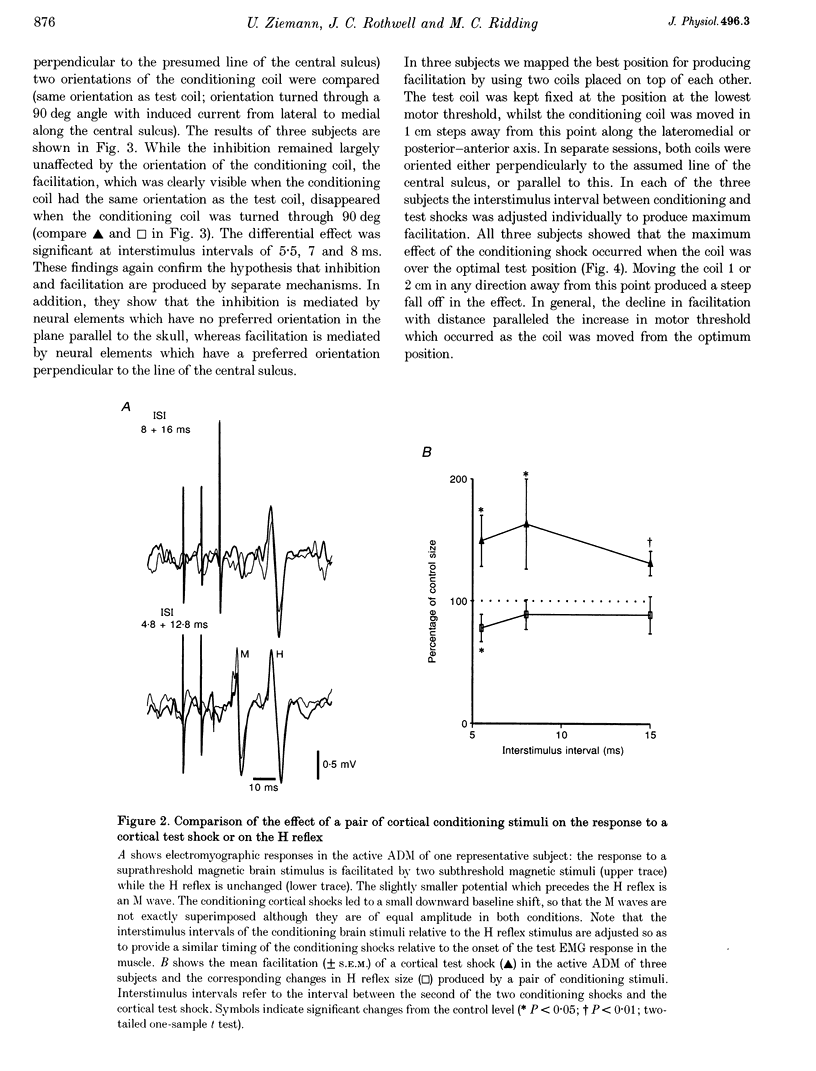


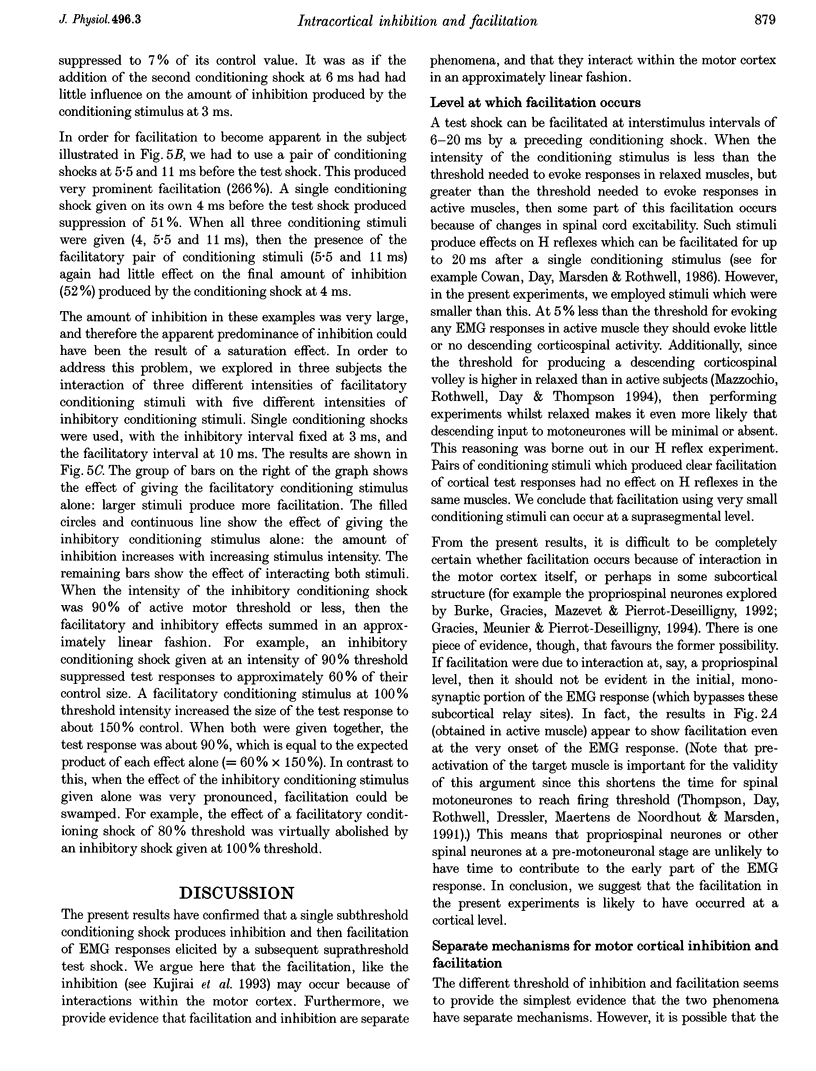
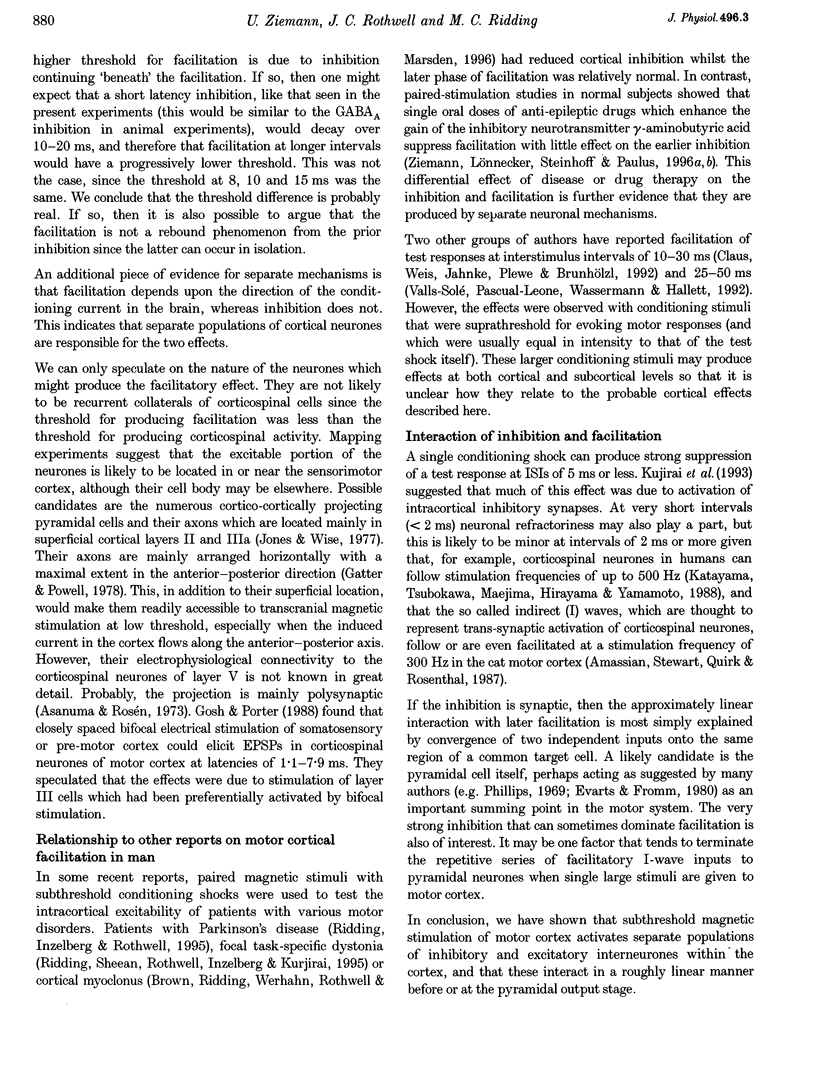
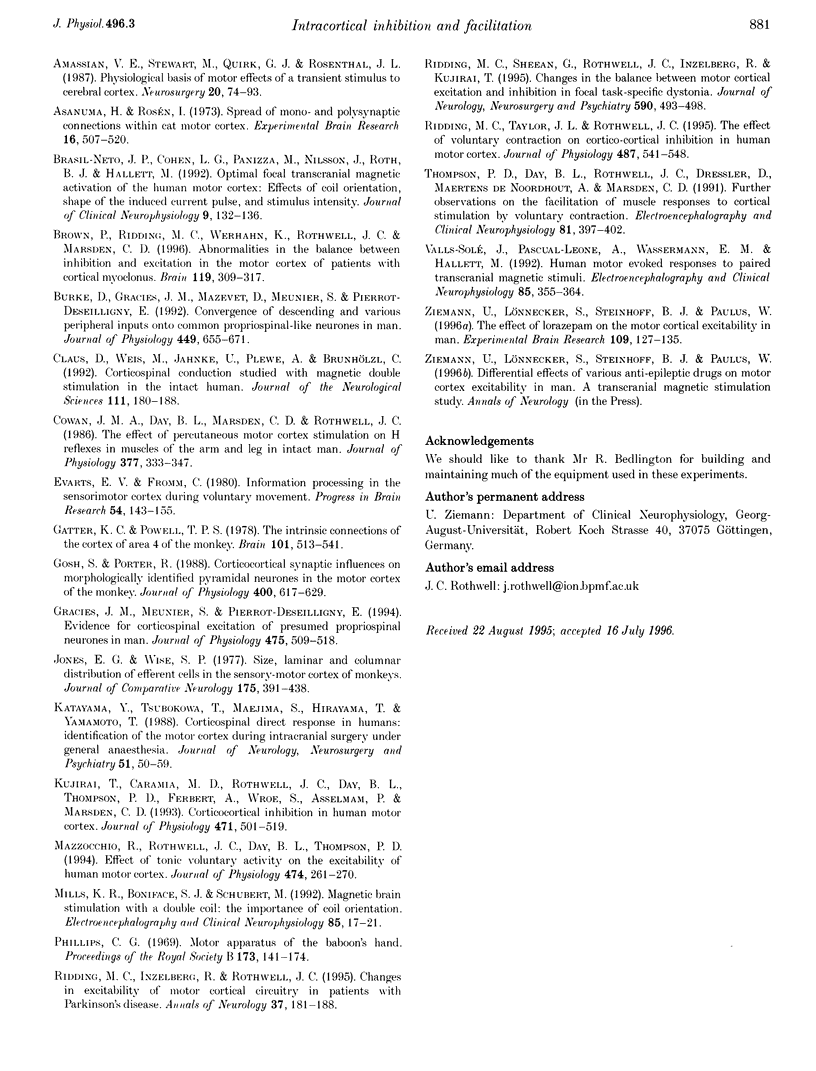
Selected References
These references are in PubMed. This may not be the complete list of references from this article.
- Amassian V. E., Stewart M., Quirk G. J., Rosenthal J. L. Physiological basis of motor effects of a transient stimulus to cerebral cortex. Neurosurgery. 1987 Jan;20(1):74–93. [PubMed] [Google Scholar]
- Asanuma H., Rosén I. Spread of mono- and polysynaptic connections within cat's motor cortex. Exp Brain Res. 1973 Mar 19;16(5):507–520. doi: 10.1007/BF00234477. [DOI] [PubMed] [Google Scholar]
- Brasil-Neto J. P., Cohen L. G., Panizza M., Nilsson J., Roth B. J., Hallett M. Optimal focal transcranial magnetic activation of the human motor cortex: effects of coil orientation, shape of the induced current pulse, and stimulus intensity. J Clin Neurophysiol. 1992 Jan;9(1):132–136. [PubMed] [Google Scholar]
- Burke D., Gracies J. M., Mazevet D., Meunier S., Pierrot-Deseilligny E. Convergence of descending and various peripheral inputs onto common propriospinal-like neurones in man. J Physiol. 1992 Apr;449:655–671. doi: 10.1113/jphysiol.1992.sp019107. [DOI] [PMC free article] [PubMed] [Google Scholar]
- Claus D., Weis M., Jahnke U., Plewe A., Brunhölzl C. Corticospinal conduction studied with magnetic double stimulation in the intact human. J Neurol Sci. 1992 Sep;111(2):180–188. doi: 10.1016/0022-510x(92)90066-t. [DOI] [PubMed] [Google Scholar]
- Cowan J. M., Day B. L., Marsden C., Rothwell J. C. The effect of percutaneous motor cortex stimulation on H reflexes in muscles of the arm and leg in intact man. J Physiol. 1986 Aug;377:333–347. doi: 10.1113/jphysiol.1986.sp016190. [DOI] [PMC free article] [PubMed] [Google Scholar]
- Evarts E. V., Fromm C. Information processing in the sensorimotor cortex during voluntary movement. Prog Brain Res. 1980;54:143–155. doi: 10.1016/S0079-6123(08)61619-2. [DOI] [PubMed] [Google Scholar]
- Ghosh S., Porter R. Corticocortical synaptic influences on morphologically identified pyramidal neurones in the motor cortex of the monkey. J Physiol. 1988 Jun;400:617–629. doi: 10.1113/jphysiol.1988.sp017139. [DOI] [PMC free article] [PubMed] [Google Scholar]
- Gracies J. M., Meunier S., Pierrot-Deseilligny E. Evidence for corticospinal excitation of presumed propriospinal neurones in man. J Physiol. 1994 Mar 15;475(3):509–518. doi: 10.1113/jphysiol.1994.sp020089. [DOI] [PMC free article] [PubMed] [Google Scholar]
- Jones E. G., Wise S. P. Size, laminar and columnar distribution of efferent cells in the sensory-motor cortex of monkeys. J Comp Neurol. 1977 Oct 15;175(4):391–438. doi: 10.1002/cne.901750403. [DOI] [PubMed] [Google Scholar]
- Katayama Y., Tsubokawa T., Maejima S., Hirayama T., Yamamoto T. Corticospinal direct response in humans: identification of the motor cortex during intracranial surgery under general anaesthesia. J Neurol Neurosurg Psychiatry. 1988 Jan;51(1):50–59. doi: 10.1136/jnnp.51.1.50. [DOI] [PMC free article] [PubMed] [Google Scholar]
- Kujirai T., Caramia M. D., Rothwell J. C., Day B. L., Thompson P. D., Ferbert A., Wroe S., Asselman P., Marsden C. D. Corticocortical inhibition in human motor cortex. J Physiol. 1993 Nov;471:501–519. doi: 10.1113/jphysiol.1993.sp019912. [DOI] [PMC free article] [PubMed] [Google Scholar]
- Mazzocchio R., Rothwell J. C., Day B. L., Thompson P. D. Effect of tonic voluntary activity on the excitability of human motor cortex. J Physiol. 1994 Jan 15;474(2):261–267. doi: 10.1113/jphysiol.1994.sp020018. [DOI] [PMC free article] [PubMed] [Google Scholar]
- Mills K. R., Boniface S. J., Schubert M. Magnetic brain stimulation with a double coil: the importance of coil orientation. Electroencephalogr Clin Neurophysiol. 1992 Feb;85(1):17–21. doi: 10.1016/0168-5597(92)90096-t. [DOI] [PubMed] [Google Scholar]
- Phillips C. G. The Ferrier lecture, 1968. Motor apparatus of the baboon's hand. Proc R Soc Lond B Biol Sci. 1969 May 20;173(1031):141–174. doi: 10.1098/rspb.1969.0044. [DOI] [PubMed] [Google Scholar]
- Ridding M. C., Inzelberg R., Rothwell J. C. Changes in excitability of motor cortical circuitry in patients with Parkinson's disease. Ann Neurol. 1995 Feb;37(2):181–188. doi: 10.1002/ana.410370208. [DOI] [PubMed] [Google Scholar]
- Ridding M. C., Sheean G., Rothwell J. C., Inzelberg R., Kujirai T. Changes in the balance between motor cortical excitation and inhibition in focal, task specific dystonia. J Neurol Neurosurg Psychiatry. 1995 Nov;59(5):493–498. doi: 10.1136/jnnp.59.5.493. [DOI] [PMC free article] [PubMed] [Google Scholar]
- Ridding M. C., Taylor J. L., Rothwell J. C. The effect of voluntary contraction on cortico-cortical inhibition in human motor cortex. J Physiol. 1995 Sep 1;487(Pt 2):541–548. doi: 10.1113/jphysiol.1995.sp020898. [DOI] [PMC free article] [PubMed] [Google Scholar]
- Thompson P. D., Day B. L., Rothwell J. C., Dressler D., Maertens de Noordhout A., Marsden C. D. Further observations on the facilitation of muscle responses to cortical stimulation by voluntary contraction. Electroencephalogr Clin Neurophysiol. 1991 Oct;81(5):397–402. doi: 10.1016/0168-5597(91)90029-w. [DOI] [PubMed] [Google Scholar]
- Valls-Solé J., Pascual-Leone A., Wassermann E. M., Hallett M. Human motor evoked responses to paired transcranial magnetic stimuli. Electroencephalogr Clin Neurophysiol. 1992 Dec;85(6):355–364. doi: 10.1016/0168-5597(92)90048-g. [DOI] [PubMed] [Google Scholar]
- Ziemann U., Lönnecker S., Steinhoff B. J., Paulus W. The effect of lorazepam on the motor cortical excitability in man. Exp Brain Res. 1996 Apr;109(1):127–135. doi: 10.1007/BF00228633. [DOI] [PubMed] [Google Scholar]


